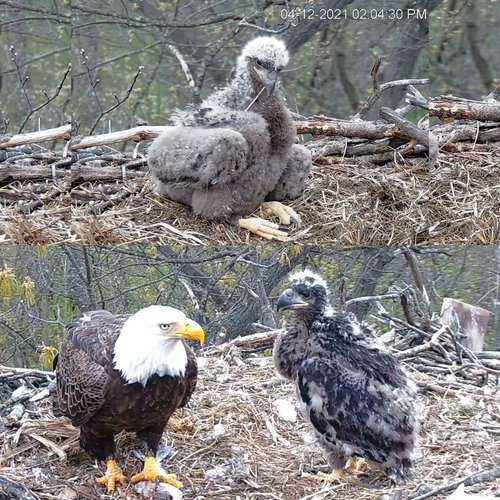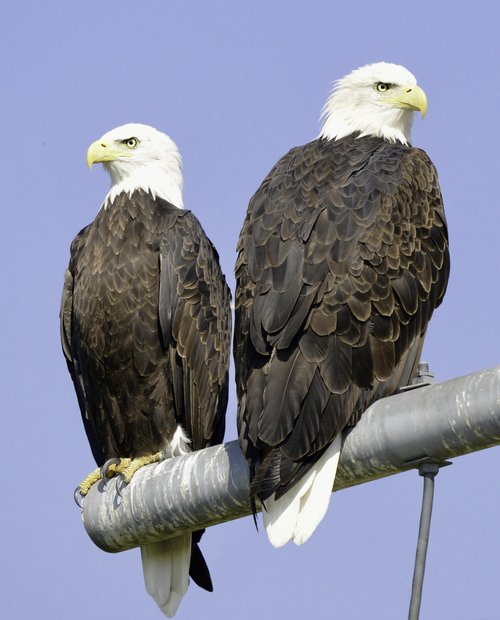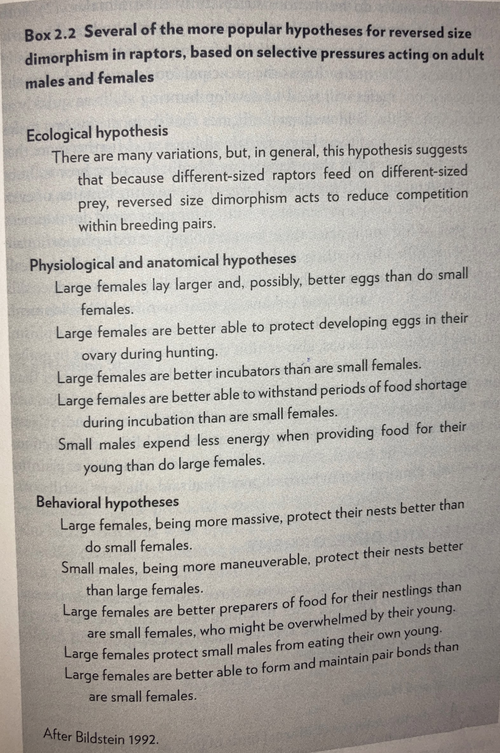Hanover Bald Eagle Blog # 16 - 2021
April 19, 2021
In partnership with Pennsylvania Game Commission and Comcast Business .
THE HANOVER NESTLING IS OFFICIALLY OVER A MONTH OLD! SINCE LAST WEEK'S BLOG THE YOUNGSTER HAS SPROUTED DARK FEATHERS ALONG ITS HEAD, WINGS, AND BACK. WHAT A DIFFERENCE ONE WEEK CAN MAKE DURING THIS PHASE OF RAPID DEVELOPMENT!

Look at the difference between April 12th, last monday, and this morning, April 19th!
The appearance of the nestling is awkwardly adorable. They continue to experiment with mobility by hobbling around the nest and testing their dexterity by picking up nest substrate, playing with sticks, and nibbling on carcass remains. We will see more of this exploratory behavior as the nestling approaches the neurological and behavioral growth phase.
Many have speculated that the nestling may be a female, and while the impressive growth rate and large size of the youngster makes this a reasonable guess, there is no way to know for sure. Researchers have determined that the sex of a nestling bald eagle can be verified after 20-24 days, but only if you measure the nestling. And even then, mistakes can and do occur. If the Hanover nestling had a sibling, we could compare their relative sizes and perhaps hedge a guess, but without more information, it’s impossible to say for sure.
However, research has suggested that the first egg in a bald eagle clutch is more likely to be a female than a male. The reasons for this “sex bias” towards females is debated, in part because it’s difficult to determine cause and effect for such a complex topic. Are the first eggs more likely to be female because females are more energy-intensive to raise? Or is the reason related to sibling aggression? Interestingly, bald eagles don’t appear to have a skewed sex ratio at the population level, meaning the number of males and females out there is close to equal. One would think that the balance might be tipped towards females, but this is not so. Whatever bald eagles are doing is working well for their species as a whole.
Adult female bald eagles are roughly 25% larger than adult males. However, as we’ve touched upon in earlier blogs, there is a notable difference in size between bald eagles living at high latitudes and those living far south. So a male bald eagle in Alaska may in fact be larger than a female bald eagle in Florida!

A male and female side-by-side, photo taken in Montana. Can you tell which is the female? Photo credit: Don Bryant
Distinct size differences between males and females for a given species is called sexual size dimorphism. For many animals, males are larger than females. Nearly all predatory birds, on the other hand, have what is called reverse sexual size dimorphism (referred to as RSD), meaning that females are larger than males. Bald eagle females are 1/3 larger than males. They possess a longer leg bone, called the tarsus, a longer toe claw, called the hallux, and have longer beaks and wings as would be expected given their overall larger size. They weigh more, and they look bigger. Raptor biologists have debated the reasons behind RSD for a long time, and though no consensus has been reached, a variety of compelling hypotheses exist.
The primary ecological suggestions are related to what a raptor eats. Species that eat fast-moving, acrobatic prey (sharp-shinned hawks) show more pronounced RSD than species that feed on "easier" prey such as mice (red-tailed hawk) or dead animals (black vulture). Sharp-shinned hawk males must be adept at capturing enough songbirds to provide for his mate, and the smaller the male, the more maneuverable he is when pursuing prey. Another ecological suggestion is that if the sexes are different sizes, they won’t compete for food. Males will catch smaller prey and the females will get the larger prey. This hypothesis does not, however, explain why the males are the smaller of the two.
Behavioral hypotheses suggest that RSD allows the larger females to better distribute food for the nestlings, defend the nest against predators, and maintain pair bonds. Smaller males may also be better able to protect the nest because they are more maneuverable.
One physiological hypothesis, proposed by the former Director of Conservation Science at Hawk Mountain, Keith Bildstein, is called the Head Start Hypothesis. This explanation focuses on the benefits of RSD during the nestling phase:
1.) Since male raptors provide most of the prey for their mates and offspring during the breeding season, they must develop quickly to become adequate hunters and therefore breed successfully. It is true that male nestlings generally develop more rapidly than their sisters, and leave the nest sooner.
2.) Given their faster growth rate, if male nestlings were as large as females, there would be a higher risk of siblicide in which males would kill the females.
Other differences between adult female and male bald eagles include the division of incubation duties with females spending more time on the nest, slight variations in vocalizations between the sexes and the female’s larger brood patch.

The following table provides a breakdown of these ideas and offers even more hypotheses things to ponder! Figure credit: Keith Bildstein, from Raptors: The Curious Nature of Diurnal Birds of Prey (2017).
The true reasons for RSD may be species-specific and involve a combination of these factors. It’s difficult to verify cause and effect without designing experiments in which a female’s large size, or a male’s small size is proven to be advantageous in increasing breeding success, survival rate, food acquisition, or other important life processes. What we do know is that female bald eagles are larger than males and their system seems to be working!
Why do you think the Hanover male is larger than the female? What benefits could arise from their difference in size? Do you think the Hanover nestling is a female or male? As a parting challenge, take a look at the following photos and see if you can tell which bird is the leading lady.

Photo Credit: April Ryan
Sources
Bortolotti, G. (1984). Criteria for Determining Age and Sex of Nestling Bald Eagles. Journal of Field Ornithology, 55(4), 467-481. Retrieved April 17, 2021, from http://www.jstor.org/stable/4512951
Dzus, E., Bortolotti, G., & Gerrard, J. (1996). Does sex-biased hatching order in bald eagles vary with food resources? Écoscience, 3(3), 252-258. Retrieved April 17, 2021, from http://www.jstor.org/stable/42900641
Watts, Bryan. (2018, January 8). Gender Divide in Bald Eagles. The Center for Conservation Biology. https://ccbbirds.org/2018/01/08/gender-divide-in-bald-eagles/
Image Credit: Don Bryant, April Ryan, and Sara Shimazu – Thank you all so very much!
ATTENTION HANOVER EAGLE VIEWERS - We recognize that over the years this bald eagle pair has been named by the public and is commonly referred to as "Freedom" and "Liberty". While we understand that naming the eagles helps connect and distinguish the female from the male eagle, naming the pair introduces an element of domesticity to wild animals. In order to respect the eagles and focus on their natural history, we will refer to the female and male as such as per recommendations of the Pennsylvania Game Commission.

RAPTOR ECOLOGY SPECIALIST - ZOEY GREENBERG
RETURN TO HANOVER BALD EAGLE BLOGS
WATCH THE HANOVER BALD EAGLE LIVE CAMS
For over 20 years, HDOnTap has provided live streaming solutions to resorts, amusement parks, wildlife refuges and more. In addition to maintaining a network of over 400 live webcams, HDOnTap specializes in design and installation of remote, off-grid and otherwise challenging live streaming solutions. Contact press@hdontap.com for all media needs, including images and recordings.